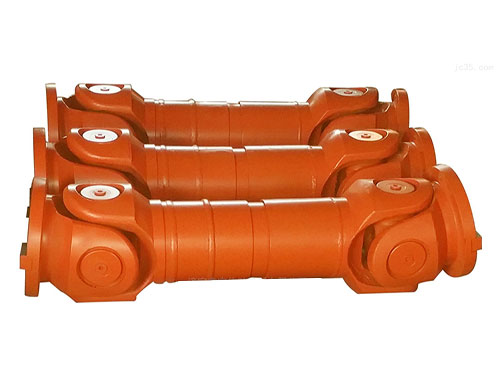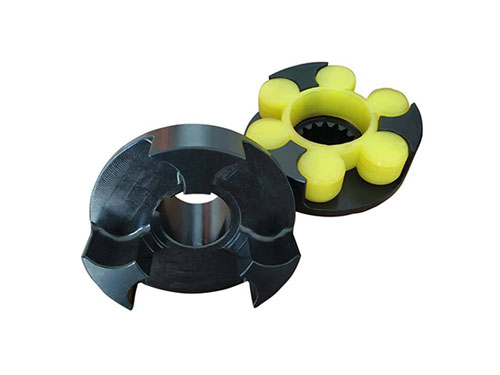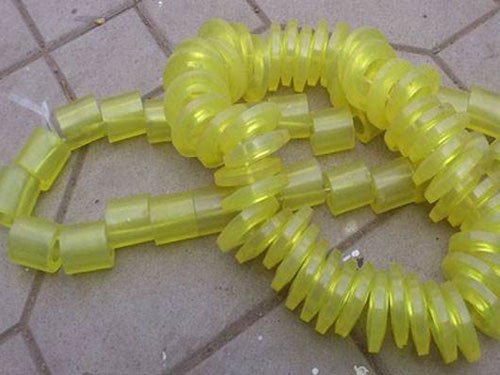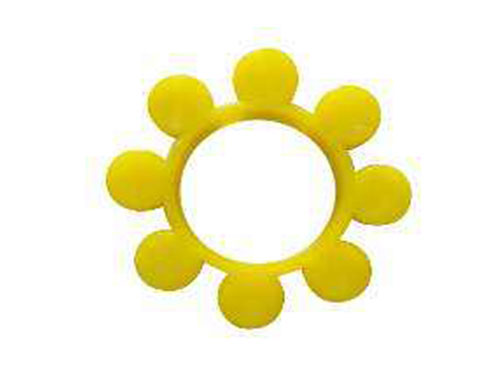 SWP-E type cross shaft universal couplingSWP-E type cross shaft universal coupling is used to...
SWP-E type cross shaft universal couplingSWP-E type cross shaft universal coupling is used to... LMZ-ⅡPlum-shaped elastic coupling with brake wheelLMZ-Ⅱ (formerly MLL-Ⅱ) type with brake wheel plum...
LMZ-ⅡPlum-shaped elastic coupling with brake wheelLMZ-Ⅱ (formerly MLL-Ⅱ) type with brake wheel plum... Elastic sleeveThe elastic sleeve uses a number of non-metal elastic...
Elastic sleeveThe elastic sleeve uses a number of non-metal elastic... Clamping spline plum blossom elastic couplingClamping spline plum blossom elastic coupling...
Clamping spline plum blossom elastic couplingClamping spline plum blossom elastic coupling... GR-shaped coupling elastic bodyGR-shaped coupling elastic body and star-shaped elastic...
GR-shaped coupling elastic bodyGR-shaped coupling elastic body and star-shaped elastic...Coupling performance and coupling bolt specifications
Coupling refers to a device that connects two shafts or a shaft and a rotating part, and rotates together in the process of transmitting movement and power, and does not disengage under normal conditions.Sometimes it is also used as a stabilizing device to prevent the connected parts from being subjected to excessive loads and play a role in overload protection.
According to different working conditions, the coupling needs to have the following performance:
XNUMX. Stable, with sufficient strength and service life.
XNUMX. Simple structure, easy to install, disassemble and maintain.
XNUMX. Movability, the mobility of the coupling refers to the ability to compensate the relative displacement of the two rotating components.Factors such as manufacturing and installation errors between the connected components, temperature changes during operation and load deformation, etc., all put forward requirements for portability.Movable performance compensation or additional load between shafts, bearings, couplings and other parts due to relative displacement between rotating components.
XNUMX. Cushioning. For occasions where the load is frequently started or the working load changes, the coupling must have elastic elements that can buffer and reduce vibration to protect the prime mover and the working machine from damage.
Couplings are also called couplings.A mechanical component used to connect the driving shaft and the driven shaft in different mechanisms to rotate together and transmit motion and torque.Sometimes it is also used to connect shafts and other parts (such as gears, pulleys, etc.).It is often composed of two halves, which are connected by keys or tight fits, respectively, and fastened to the ends of the two shafts, and then the two halves are connected in some way.The coupling can also compensate for the offset between the two shafts due to inaccurate manufacturing and installation, deformation or thermal expansion during work, etc. (including axial offset, radial offset, angular offset or comprehensive offset) ; And alleviate impact and absorb vibration.
Coupling bolts have many specifications. According to the force mode of the connection, they are divided into ordinary ones and those with reamed holes.According to the shape of the head: there are hexagonal head, round head, square head, countersunk head and so on.The hexagonal head is commonly used.The countersunk head is generally used where connection is required.The application is especially common.The maintenance is convenient and the service life is long. The nylon pin can be replaced by removing the baffle plate. The nylon pin is self-lubricating material and does not need lubrication, which not only saves lubricating oil, but also purifies the working environment.The transmission torque is large. At the same torque, the rotating diameter is mostly smaller than the gear coupling, the volume is small, and the weight is lighter. It can partially replace the gear coupling. Compared with the gear coupling, the structure is simple and the composition is There are fewer parts and it is more convenient to manufacture, without gear processing machine tools.
XNUMX. After the rotor rotates, the two couplings should not be crappy, the markings should be aligned, take care not to rub the rotor with other parts, and do not touch the dial indicator tool during operation.
XNUMX. After adjusting the center distance, apply the aforementioned method to check, and adjust the center when the center is unqualified.Then the qualified center is rechecking twice, and the values measured in the two times should have little error.
XNUMX. Before finding the center, install the pump so that the center deviation of the two couplings should be as small as possible, and the motor anchor bolts should be tightened first.At the same time, continuously rotate the rotor several times to compress the bearing.
XNUMX. When centering, the motor should be adjusted based on the pump coupling.
XNUMX. The right-angle bracket should be correct, flexible, and the surface of the measuring point should be smooth.At the same time pay attention to the indicated value of the pointer.
Compressors, fans, and pumps, as basic fluid conveying machinery, are commonly used in various types of production, and as couplings that connect such equipment to motors, they play a particularly critical role in operation.Pump couplings are basically classified into these categories. Pumps are one of the most commonly used chemical machines. Medium and small pumps generally use elastic couplings.High-power axial-flow pumps and water-turbine pumps often use synchronous motors as prime movers and use flange couplings for transmission. High-power pumps with higher speeds often use gear couplings.When the medium conveyed in the centrifugal pump is a suspension of small particles, belt transmission is generally used, such as the PH type ash pump and PS type sand pump using belt transmission.High-speed centrifugal pumps have been widely used in chemical plants this year. When the pump speed is greater than XNUMX, Thomas couplings are generally used. For high-power high-speed centrifugal pumps, gear couplings should be used. Over the dynamic balance test.
Couplings can be divided into two categories: rigid couplings and flexible couplings.
Rigid couplings do not have the ability to buffer and compensate for the relative displacement of the two axes. They require strict alignment of the two axes. However, this type of coupling has simple structure, low manufacturing cost, convenient assembly and disassembly, and maintenance. High neutrality, large transmission torque, universal application.Commonly used are flange couplings, sleeve couplings and clamp couplings.
Flexible couplings can be divided into flexible couplings without elastic elements and flexible couplings with elastic elements. The former type only has the ability to compensate the relative displacement of the two axes, but it cannot buffer and reduce vibration. The common ones are slippery. Block couplings, gear couplings, universal couplings and chain couplings, etc.; the latter type contains elastic elements, which not only has the ability to compensate for the relative displacement of the two axes, but also has buffering and damping functions. However, the transmitted torque is limited by the strength of the elastic element, and is generally not as good as the flexible coupling without elastic elements. Commonly used are elastic sleeve pin couplings, elastic pin couplings, plum-shaped couplings, and tire-type couplings. Couplings, serpentine spring couplings and reed couplings, etc.